Acetate Record Labels
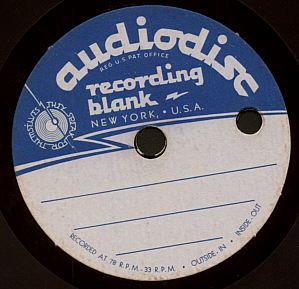
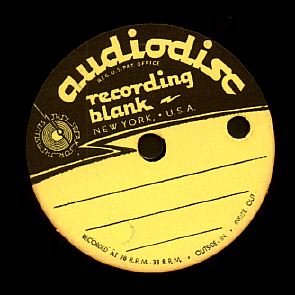 Audiodisc, made by Audio Devices Inc. They
offered yellow, blue and red label discs as well as fiber base discs
and slightly larger than standard diameter mastering blanks which
were used for recordings that were used to dub off additional
copies.
Audiodisc, made by Audio Devices Inc. They
offered yellow, blue and red label discs as well as fiber base discs
and slightly larger than standard diameter mastering blanks which
were used for recordings that were used to dub off additional
copies.
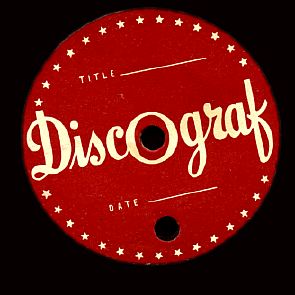
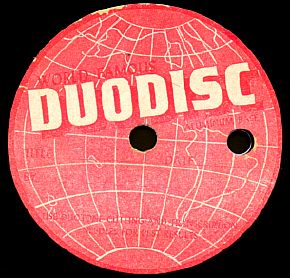 The DiscOgraf is one of the few 8 inch
GLASS base discs I've discovered. Outstanding sound quality,
extremely fragile, and thicker than any other discs making it a pain
to readjust the lathe or record cutter. Standard Duodisc aluminum
base disc on the right.
The DiscOgraf is one of the few 8 inch
GLASS base discs I've discovered. Outstanding sound quality,
extremely fragile, and thicker than any other discs making it a pain
to readjust the lathe or record cutter. Standard Duodisc aluminum
base disc on the right.
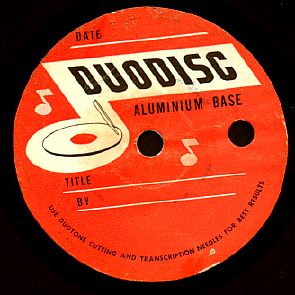
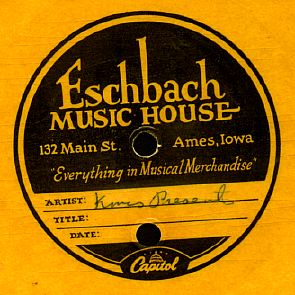 Another version of the Duodisc label and a
Capitol fiber base disc. These were made up custom for music, radio
and electronic stores so they could then offer their own line of
blanks for the home recordist. This is a 6 inch cardboard
disc.
Another version of the Duodisc label and a
Capitol fiber base disc. These were made up custom for music, radio
and electronic stores so they could then offer their own line of
blanks for the home recordist. This is a 6 inch cardboard
disc.
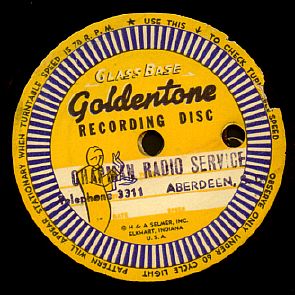
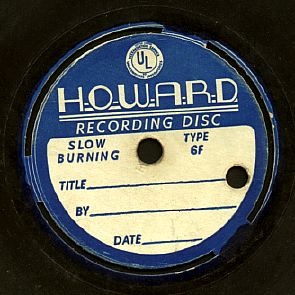 The Goldentone, another 8 inch glass base
disc. Interesting that the design around the label is actually a
strobe disc that allows you to check the speed of your machine. The
Howard is a 6 inch cardboard disc. Note the slots around the label.
Too big to be a punch out for 45, I have no idea what their purpose
may be.
The Goldentone, another 8 inch glass base
disc. Interesting that the design around the label is actually a
strobe disc that allows you to check the speed of your machine. The
Howard is a 6 inch cardboard disc. Note the slots around the label.
Too big to be a punch out for 45, I have no idea what their purpose
may be.
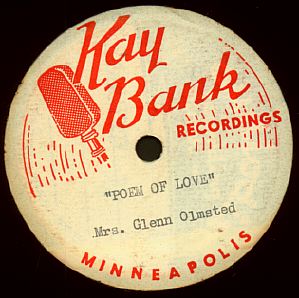
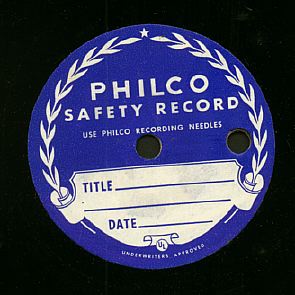 Recording studios would have their own
labels made for their custom recordings. Here a Kay Bank studio label
affixed over a standard Audiodisc label. The Philco is a STEEL base
record. During World War II aluminum was being sent for the war
effort and disc makers tried to meet demand with steel base discs.
they are heavy and the acetate coating did not stick to the steel
well.
Recording studios would have their own
labels made for their custom recordings. Here a Kay Bank studio label
affixed over a standard Audiodisc label. The Philco is a STEEL base
record. During World War II aluminum was being sent for the war
effort and disc makers tried to meet demand with steel base discs.
they are heavy and the acetate coating did not stick to the steel
well.
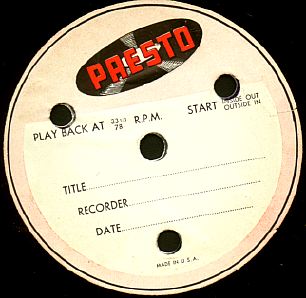
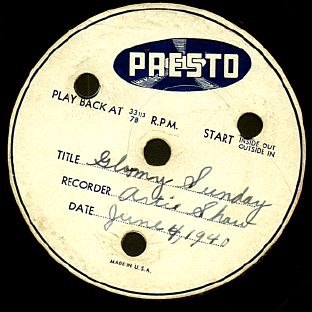 Just a couple variations on the popular
Presto discs. Presto made good quality discs right up there with the
Audiodisc. They also made a fine line of popular recording
lathes.
Just a couple variations on the popular
Presto discs. Presto made good quality discs right up there with the
Audiodisc. They also made a fine line of popular recording
lathes.
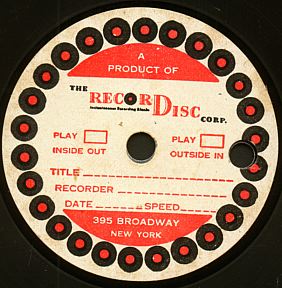
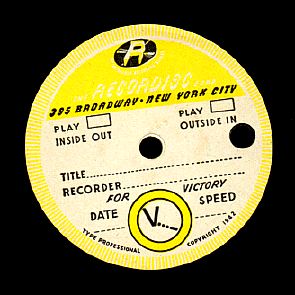 Two different labels from RecorDisc. On
the left a standard 10 inch aluminum base disc with label and on the
right the label from a 6 inch fiber base disc. These were made in
huge quantity and sold specifically for use during WWII for family
members to send to GI's and for GI's to record messages to send back
home.
Two different labels from RecorDisc. On
the left a standard 10 inch aluminum base disc with label and on the
right the label from a 6 inch fiber base disc. These were made in
huge quantity and sold specifically for use during WWII for family
members to send to GI's and for GI's to record messages to send back
home.
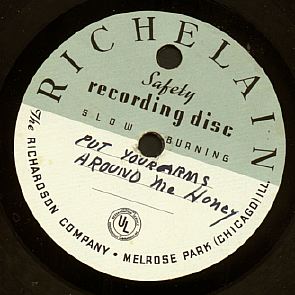
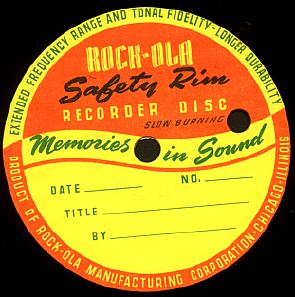 Richelain provided an economy line of 6
inch cardboard base discs, and the Rock-Ola is a mastering disc made
of thicker aluminum, 11 inches in diameter with a green additional
rim around the outside edge to facilitate clamping to a machine from
which copies would be dubbed.
Richelain provided an economy line of 6
inch cardboard base discs, and the Rock-Ola is a mastering disc made
of thicker aluminum, 11 inches in diameter with a green additional
rim around the outside edge to facilitate clamping to a machine from
which copies would be dubbed.
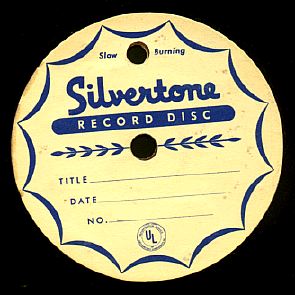
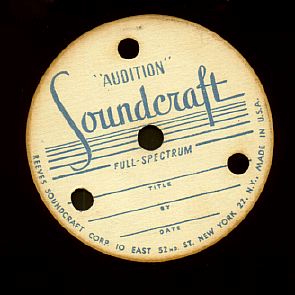 Silvertone, from Sears of course. Sears
sold their own line of home disc recorders, and naturally had to
provide their customers with their own line of blanks. Soundcraft
another name in quality recording discs. Provided them for many
recording studios and radio stations. In the movie "Elvis '56" you
can see Elvis flipping thru some acetate demos, on the top of the
stack is a Soundcraft disc.
Silvertone, from Sears of course. Sears
sold their own line of home disc recorders, and naturally had to
provide their customers with their own line of blanks. Soundcraft
another name in quality recording discs. Provided them for many
recording studios and radio stations. In the movie "Elvis '56" you
can see Elvis flipping thru some acetate demos, on the top of the
stack is a Soundcraft disc.
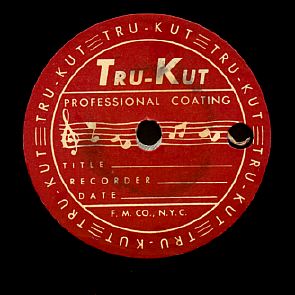
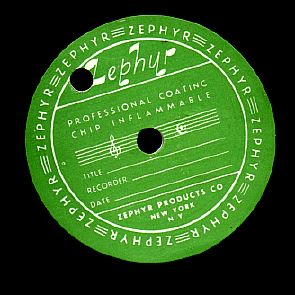 Many companies made blanks, heres a couple
from Tru-Kut and Zephyr.
Many companies made blanks, heres a couple
from Tru-Kut and Zephyr.
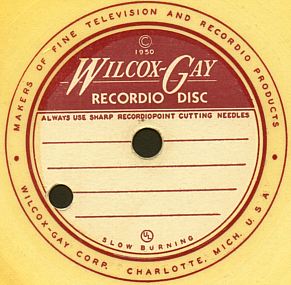
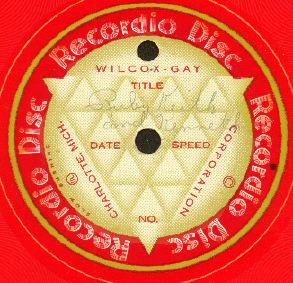 It was the Wilcox-Gay company that first
brought disc recording into the home. They made the machines more
user friendly so Mom and Dad could make records in the living room.
(Click here to read my
Antique Radio Classified article of a few years ago on the W-G
company, complete with photos). Hence they
made a LOT of different recording blanks. Small and large, cardboard
and aluminum, even steel during the war, and even a 7 incher with
punch out larger hole for 45's. Above a couple fiber base W-G blanks,
the left a 6 incher, the right a red 8 incher.
It was the Wilcox-Gay company that first
brought disc recording into the home. They made the machines more
user friendly so Mom and Dad could make records in the living room.
(Click here to read my
Antique Radio Classified article of a few years ago on the W-G
company, complete with photos). Hence they
made a LOT of different recording blanks. Small and large, cardboard
and aluminum, even steel during the war, and even a 7 incher with
punch out larger hole for 45's. Above a couple fiber base W-G blanks,
the left a 6 incher, the right a red 8 incher.
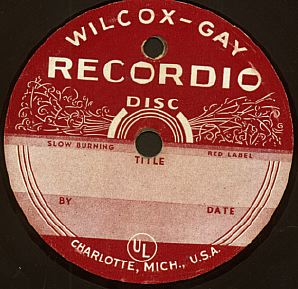
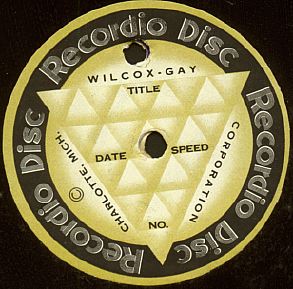 The label on the left used on early
blanks, both cardboard and steel base. The right is an intricate
label from a 10 inch aluminum disc.
The label on the left used on early
blanks, both cardboard and steel base. The right is an intricate
label from a 10 inch aluminum disc.
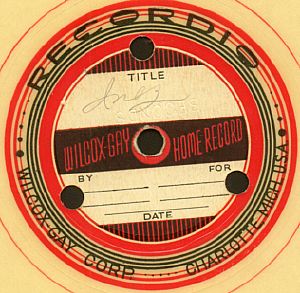
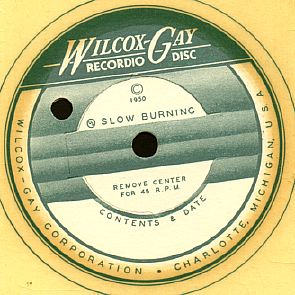 And two more from W-G, both fiber based
note the one on the right has a punch out to play on a large spindle
45 player. Note it was made in 1950, right after RCA introduced the
45.
E-Mail
Me
Back to the Table
of Contents
Read my article
from A.R.C.
And two more from W-G, both fiber based
note the one on the right has a punch out to play on a large spindle
45 player. Note it was made in 1950, right after RCA introduced the
45.
E-Mail
Me
Back to the Table
of Contents
Read my article
from A.R.C.

